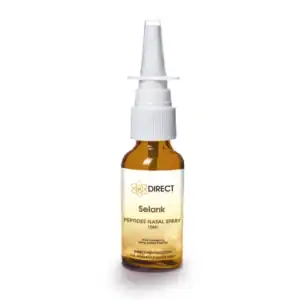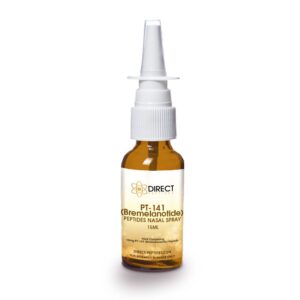Please be aware of our revised hours during the holiday season. We will operate on a half-day schedule on December 24th and 31st and will be CLOSED from December 25th to 28th, with limited customer service available. We will fully REOPEN on December 29th and again on January 2nd.
Nasal peptides have gained significant attention in scientific research. They are especially studied in the fields of neurology, cognitive function, and neurodegenerative diseases.
Unlike traditional drug administration methods, nasal drug delivery systems offer a direct pathway to the central nervous system (CNS). This is because they bypass the blood-brain barrier.
The use of peptide drugs in research aims to explore their effectiveness in addressing conditions such as Alzheimer’s disease, mild cognitive impairment, and Parkinson disease.
Various studies suggest that these peptides may contribute to memory enhancement, neuroprotection, and metabolic regulation. This makes them a crucial area of focus for researchers.
Previous studies highlight the role of nasal mucosa and the olfactory epithelium in improving drug absorption. These structures also enhance peptide efficacy in the human body.
In this article, we will delve into the science behind nasal peptides. We will discuss their mechanisms of action, potential research applications, and the findings from randomized clinical trials and animal studies.
Nasal peptides use the nasal cavity and olfactory epithelium to reach brain regions. They serve as an efficient research tool for CNS disorders. The olfactory region provides a direct path to the brain.
It does this through passive diffusion, endocytosis, and receptor-mediated transport. Peptides interact with insulin receptors and neurotrophic factors. These interactions help them move into the CNS.
Unlike traditional drug methods, such as oral intake or injections, nasal drug delivery allows faster absorption. It increases bioavailability and improves CNS targeting. This method is useful for studies on cognitive decline, insulin resistance, and metabolic disorders.
In recent years, America researchers have examined how amino acids and small molecules enhance peptide absorption. They also study how these molecules improve therapeutic potential. A research group in drug development has been investigating how different nasal drug devices optimize absorption across the nasal mucosa.
Direct Peptides America has premium quality research nasal peptides for sale online, shop today!
Scientific research shows that peptide delivery through nasal drug delivery systems interacts with cerebrospinal fluid, the spinal cord, and brain regions. Studies on Google Scholar explore how nasal peptides affect cognitive function in Alzheimer’s disease models.
They also increase neurotrophic factor expression, which boosts nerve growth factor activity. These peptides impact memory impairment linked to CNS disorders.
The pharmaceutical industry works to improve nasal delivery devices. The goal is better absorption and higher efficiency in research applications.
Transgenic mice models help America researchers study peptide behavior in neurodegenerative disorders. Findings show that a single dose of certain peptides can cause measurable cognitive changes.
Peptide development for targeted therapies remains a top priority. Scientists focus on signaling pathways that regulate neuronal growth and repair. Pilot trials test peptide absorption and efficacy. These trials focus on older adults with neurodegenerative conditions.
The growing interest in nasal peptides comes from their unique advantages. They target the brain directly. They bypass systemic circulation. They also minimize peptide degradation. This maximizes research potential in cognitive disorders.
Studies show promising results. They improve cognitive enhancement, learning capacity, and neurological health. Unlike injections, nasal administration is non-invasive. It is useful for research applications.
Peptides classified as large molecules have a high molecular weight. They have been studied for treating neurodegenerative diseases. Advances in nasal drug delivery systems have improved peptide transport. They now pass more efficiently through mucous membranes in the respiratory region.
PT-141 was first developed as a research compound for sexual dysfunction. Later studies suggest it may also affect the nervous system. Unlike drugs that act on the vascular system, PT-141 stimulates CNS pathways. This makes it a candidate for studies in neurological function, repetitive behaviors, and mood regulation.
Research shows that PT-141 may influence cognitive function and CNS activity. It has been studied for its role in dopamine modulation. This makes it a potential research subject in neurodegenerative disorders such as Parkinson’s disease.
Investigations continue to explore its effects on neuroprotection. Scientists also study how it interacts with neurotransmitter receptors in the brain.
Find out more about PT-141 Peptides here.
 Oxytocin, often called the ‘love hormone,’ is widely studied. It plays a role in social bonding, stress regulation, and emotional processing.
Oxytocin, often called the ‘love hormone,’ is widely studied. It plays a role in social bonding, stress regulation, and emotional processing.
America Researchers have tested intranasal administration in randomized clinical trials. These studies focus on autism spectrum disorders, schizophrenia, social anxiety, and cognitive enhancement.
Findings show that oxytocin sprays reach the olfactory bulb and CNS. This makes them useful for neuropsychological research.
Scientists study how oxytocin affects dopamine and serotonin. These pathways help with emotional regulation and stress response. Researchers are also exploring its role in post-traumatic stress disorder (PTSD).
Oxytocin is available in various formats for research.
BPC-157 and TB500 are two peptides gaining attention in research. They are studied for tissue regeneration, neuroprotection, and metabolic recovery. Researchers have explored their effects on spinal cord healing, systemic circulation, and cellular repair.
These peptides reduce inflammation, improve neuroplasticity, and speed up healing. This makes them important in regenerative medicine research.
Learn more about BPC-157’s healing properties.
BPC-157 and TB500 are studied in sports medicine and trauma recovery. They may enhance muscle and joint healing. America Studies also suggest they may help treat neuroinflammatory disorders and autoimmune conditions.
Their role in neurodegeneration is under investigation. Scientists study how they regulate inflammatory responses. They also examine their impact on tissue regeneration in the CNS.
Learn more about TB500 peptides today.
Selank was first developed in Russia. It has been studied for cognitive enhancement. Researchers also study its effects on anxiety reduction and immune modulation.
Studies with healthy matched controls and animal models suggest its role in neuroprotection. It also affects neurotransmitter balance and immune system support.
Selank Spray influences neurotrophic factor expression. This helps brain function. It also supports cognitive stability. Scientists are exploring its effects on stress adaptation, depression, and attention deficit hyperactivity disorder (ADHD).
Research continues on its broader applications. Scientists study its role in mental health. They also examine its effects on neurocognitive disorders.
Discover the full range of Selank Peptides here.
Side effects of using nasal peptides may include nasal irritation, dryness, or itching. It is essential to consult a healthcare professional before using them, especially if you have any underlying medical conditions or are taking other medications to avoid potential adverse reactions.
Peptides hold promise, but challenges remain. The effectiveness of absorption varies. It depends on peptide structure, the delivery device, and individual physiology. Many studies rely on animal models. More human trials are needed to understand long-term effects.
Regulatory bodies continue to evaluate safety. Researchers must follow pharmaceutical guidelines. This ensures progress in clinical applications. Better drug delivery devices may help. They could solve some problems and improve peptide-based research.
The field of nasal peptide research continues to grow. Interest in therapeutic applications is increasing. Researchers study treatments for neurodegenerative diseases, metabolic disorders, and cognitive health.
Emerging technologies, including nasal delivery systems, may improve peptide uptake. They could also enhance effectiveness. Further studies on peptide hormones in CNS function may provide valuable insights.
These studies could help researchers develop new treatments in neurological medicine. Scientists are also investigating their role in growth hormone regulation.
Clinical trials are important for proving the effectiveness of nasal peptides. Research shows promising effects in cognitive disorders. However, larger human studies are needed to confirm these findings.
Ongoing randomized controlled trials are testing how nasal peptides affect the CNS. Scientists are also studying their role in treating diseases such as Alzheimer’s, Parkinson’s, and diabetes mellitus. More research in this area will help unlock new treatment possibilities.
Nasal peptides are a new area of scientific research. They bypass systemic circulation and interact directly with the CNS. This makes them a promising subject for continued study. Scientists examine their effects on neurological function, cognitive performance, and disease management.
As research grows and nasal drug delivery devices improve, their therapeutic potential may increase. These peptides could change how we treat neurological conditions, metabolic disorders, and cognitive decline. Future advancements may lead to better therapies. These treatments could improve patient outcomes and expand medical possibilities.
Nasal Sprays are available Online from Direct Peptides America. Peptide Nasals offer a convenient alternative to researching peptides without the use of injections.
[1] Jeong SH, Jang JH, Lee YB. Drug delivery to the brain via the nasal route of administration: exploration of key targets and major consideration factors. J Pharm Investig. 2023;53(1):119-152.
[2] Meredith ME, Salameh TS, Banks WA. Intranasal Delivery of Proteins and Peptides in the Treatment of Neurodegenerative Diseases. AAPS J. 2015 Jul;17(4):780-7.
[3] Kim S, Cho MC, Cho SY, Chung H, Rajasekaran MR. Novel Emerging Therapies for Erectile Dysfunction. World J Mens Health. 2021 Jan;39(1):48-64.
[4] Lee MR, Wehring HJ, McMahon RP, Liu F, Linthicum J, Buchanan RW, Strauss GP, Rubin LH, Kelly DL. The Effect of Intranasal Oxytocin on Measures of Social Cognition in Schizophrenia: A Negative Report. J Psychiatr Brain Sci. 2019;4(1):e190001.
[5] Sudarkina OY, Filippenkov IB, Stavchansky VV, Denisova AE, Yuzhakov VV, Sevan’kaeva LE, Valieva LV, Remizova JA, Dmitrieva VG, Gubsky LV, Myasoedov NF, Limborska SA, Dergunova LV. Brain Protein Expression Profile Confirms the Protective Effect of the ACTH(4-7)PGP Peptide (Semax) in a Rat Model of Cerebral Ischemia-Reperfusion. Int J Mol Sci. 2021 Jun 8;22(12):6179.
[6] Molinoff PB, Shadiack AM, Earle D, Diamond LE, Quon CY. PT-141: a melanocortin agonist for the treatment of sexual dysfunction. Ann N Y Acad Sci. 2003 Jun;994:96-102.

Selank Nasal Spray
£42.58 – £79.16Price range: £42.58 through £79.16 Select options This product has multiple variants. The options may be chosen on the product page
TB500 & BPC-157 Blend Nasal Spray
£85.00 – £165.00Price range: £85.00 through £165.00 Select options This product has multiple variants. The options may be chosen on the product page
PT-141 (Bremelanotide) Nasal Spray
£29.45 – £53.90Price range: £29.45 through £53.90 Select options This product has multiple variants. The options may be chosen on the product page
Oxytocin Nasal Spray
£20.64 – £36.29Price range: £20.64 through £36.29 Select options This product has multiple variants. The options may be chosen on the product pageALL CONTENT AND PRODUCT INFORMATION AVAILABLE ON THIS WEBSITE IS FOR EDUCATIONAL PURPOSES ONLY.
DISCLAIMER: These products are intended solely as a research chemical only. This classification allows for their use only for research development and laboratory studies. The information available on our America Direct Peptides website: https://direct-peptides.com is provided for educational purposes only. These products are not for human or animal use or consumption in any manner. Handling of these products should be limited to suitably qualified professionals. They are not to be classified as a drug, food, cosmetic, or medicinal product and must not be mislabelled or used as such.